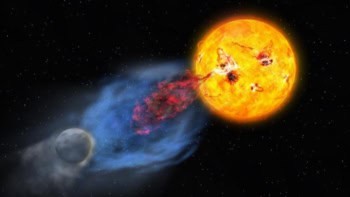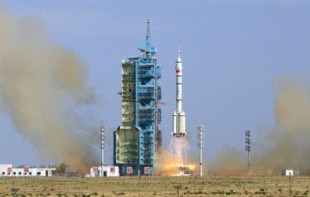
A mission to study the Sun in greater detail than ever before has been launched today from Cape Canaveral, Florida. NASA‘s $850m Solar Dynamics Laboratory (SDO) will use a suite of extremely sensitive instruments to make a wide range of measurements of the Sun – charting solar disturbances from their origins deep inside the core of the star to their appearance on the surface and their rapid ejection into space.
The SDO is the first – and will eventually be the largest – mission to emerge from NASA’s Living With a Star programme, which was launched in 2001 to gain a better understanding of how solar storms affect life on Earth. In the worst case, they could lead to geosynchronous satellites being knocked out by high-energy particles entering the atmosphere or to power supplies on the Earth’s surface being severely damaged, debilitating telecommunications, navigation based on Global Positioning System satellites, banking and transport networks.
The SDO will initially operate for five years with the possibility to run for a further five years after that. “It will observe the Sun faster, deeper and in greater detail than any previous observatory,” says astrophysicist Madhulika Guhathakurta, the mission’s programme scientist.
Solar strength
The cause of the Sun’s volatility lies in its magnetic field, which results from the continual churning of the charged plasma surrounding its core. Because the solar equator rotates more quickly than the poles, the magnetic field becomes twisted and entangled, producing regions of dense field lines that extend outwards from the centre of the Sun and which restrict the upward convection of heat. This leads to the dark patches on the solar surface known as sunspots that are seen to vary in number and position over an 11-year cycle.
It will observe the Sun faster, deeper and in greater detail than any previous observatory astrophysicist Madhulika Guhathakurta, mission programme scientist
The last solar cycle apparently lasted for 12.5 years, therefore delaying the build up of the current cycle, which started with a sunspot observed on 4 January 2008. This cycle is now picking up with the peak in activity expected in 2013, so the SDO is well timed to observe the build-up of this activity.
The disruptive phenomena associated with sunspot activity are believed to be caused by the huge amounts of energy released when the entangled fields reach breaking point and suddenly disentangle. These phenomena include solar flares – explosions in the Sun’s atmosphere that accelerate charged particles and emit broadband electromagnetic radiation – as well as coronal mass ejections – enormous expulsions of plasma threaded with magnetic fields that push against the charged particles of the solar wind and create a shock wave that batters the protective bubble provided by the Earth’s magnetic field.
Eric Priest, a solar physicist at the University of St Andrews in the UK, describes the SDO as “brilliantly conceived and designed” and says that it will lead to “a major advance in our understanding” of the Sun’s variability.
Peering beneath the solar skin
The SDO has been placed in an inclined geosynchronous orbit – in other words, it rotates around the Earth exactly once a day but does so at a finite angle to the equator. This orbit has two big advantages: the Sun can be almost continuously observed (apart from a few weeks a year when the satellite will be eclipsed by the Earth) and the spacecraft will have nearly continuous contact with a single, dedicated ground station, allowing fast, real-time data transmission. However, the high altitude required for such an orbit has meant a relatively expensive launch and protection against the very effects of space weather that the spacecraft is designed to study.
To carry out its studies the SDO will use three instruments. The Atmospheric Imaging Assembly consists of an array of four telescopes that will produce a continuous stream of high-definition images of the surface and atmosphere of the Sun in 10 wavelength bands. This high resolution in both time and wavelength means that the SDO will be far better placed to observe individual solar events with short duration and a narrow spectrum than were previous observatories. As such, says Guhathakurta, it may explain why the atmospheric corona, at 1–2 million degrees Kelvin is so much hotter than the surface of the Sun, which is just a few thousand Kelvin. (One theory is that the corona is maintained at such extremely high temperatures by mini solar flares.)
Moving beyond the visible, solar scientists will use the Extreme Ultraviolet Variability Experiment to study sunlight between 0.1 and 105 nm. Unlike total solar irradiance, which typically varies by just a fraction of a per cent over a solar cycle, emissions at extreme ultraviolet wavelengths can fluctuate by a factor of 1000 or more within the space of a few seconds. This radiation is largely responsible for heating and therefore ionizing the Earth’s upper atmosphere, which can alter and sometimes severely disturb radio communications.
The new observatory will not just be capable of observing the visible and ultraviolet output of the Sun, however. Using the Helioseismic and Magnetic Imager (HMI) it will also be able to study what is happening inside the Sun, and in particular probe the origin of the solar magnetic field, by virtue of the sound waves and magnetic fields on the solar surface. The speed of these sound waves is determined by what the waves encounter as they travel through the Sun, and this speed can be calculated by measuring the Doppler shift of spectral lines within the sunlight as measured across the solar disk. Likewise, the polarization of these same spectral lines reveals the magnetic field over the visible face of the Sun.
[The SDO] will be a major advance in our understanding of the Sun’s variability Eric Priest, a solar physicist at the University of St Andrews, UK
According to Guhathakurta, the HMI will allow researchers to work out what is happening on the far side of the Sun and identify regions of strong magnetic field that could migrate to the front of the Sun and cause geomagnetic storms. Because such migration can take up to two weeks, these data could allow significantly longer-term forecasts of space weather than the two or three days currently provided by NASA’s STEREO mission.
Bernhard Fleck, project scientist of the currently operating Solar Heliospheric Observatory (SOHO), which is a joint project of NASA and the European Space Agency, believes that the SDO is likely to yield “very significant advances” in solar science. He likens the difference between the imaging capabilities of the SDO and SOHO to the gulf between state-of-the-art single-lens reflex (SLR) digital cameras and the first devices to be incorporated into mobile phones. But he points out that predicting space weather requires understanding all the elements in a long chain that links processes inside the Sun to those on the solar surface and outwards into the solar system.
Achieving this, he says, will involve combining the results from the SDO with those of the other existing solar observatories and with those of the other missions that will make up Living With a Star and which are due to take off over the coming decade. These missions include radiation belt storm probes, due for launch in 2012 and designed to study the plasma processes responsible for geomagnetic storms. Solar Probe Plus, on the other hand, will make measurements within the Sun’s corona.




